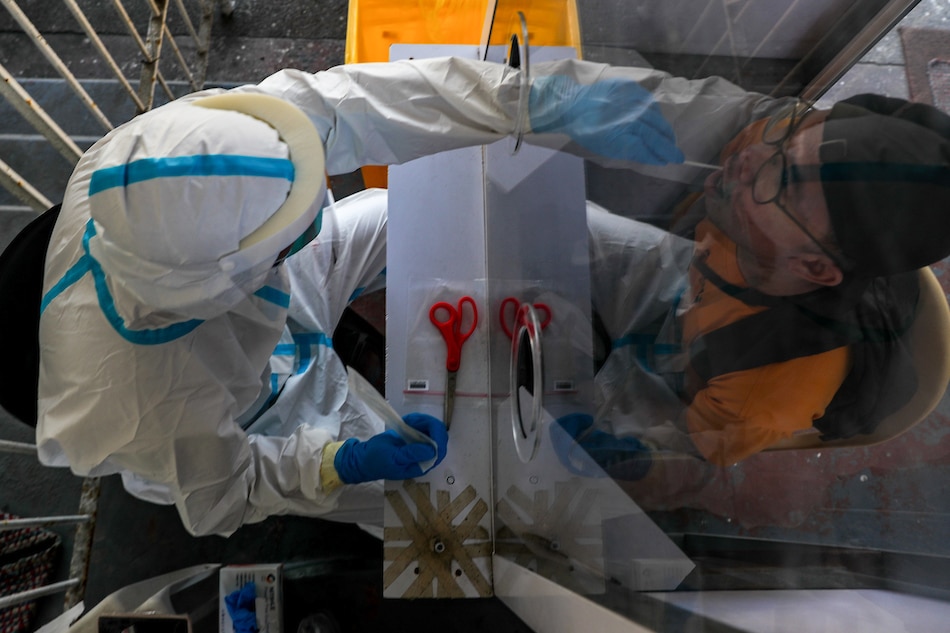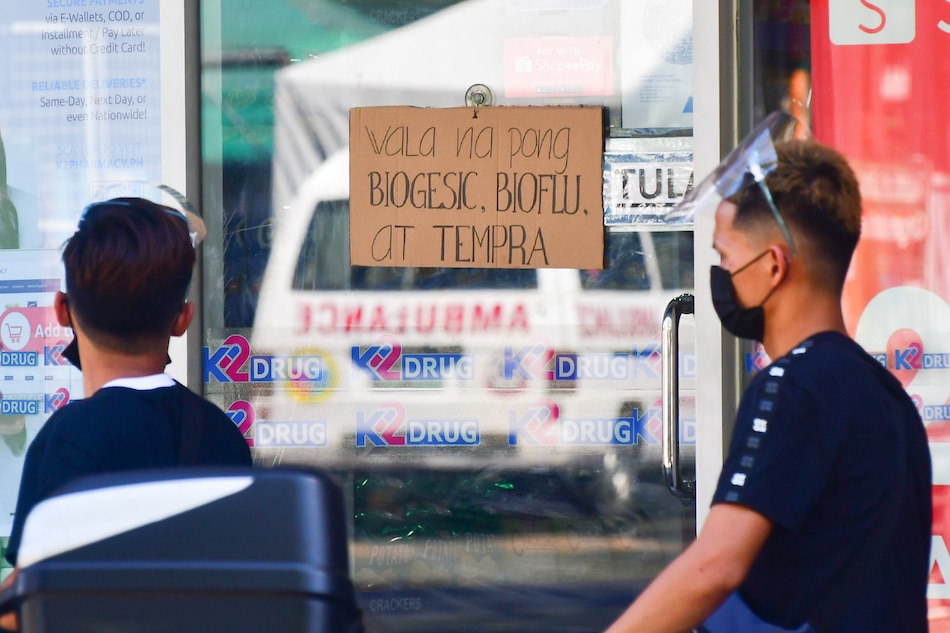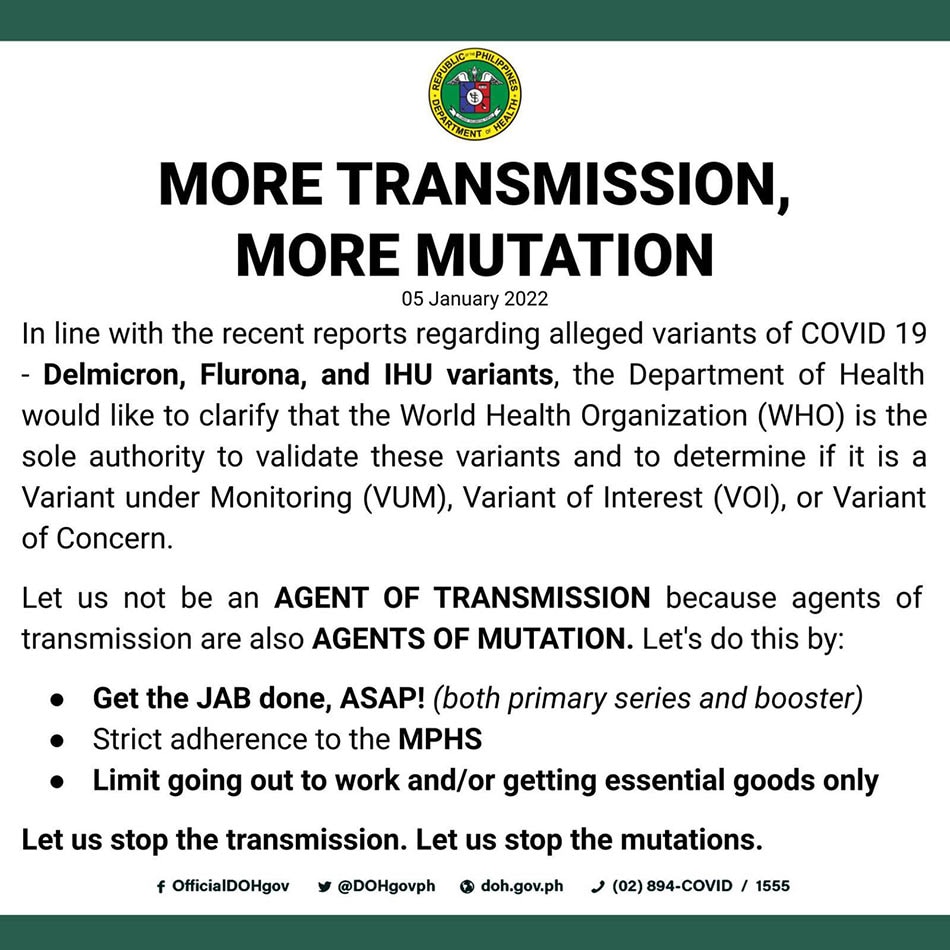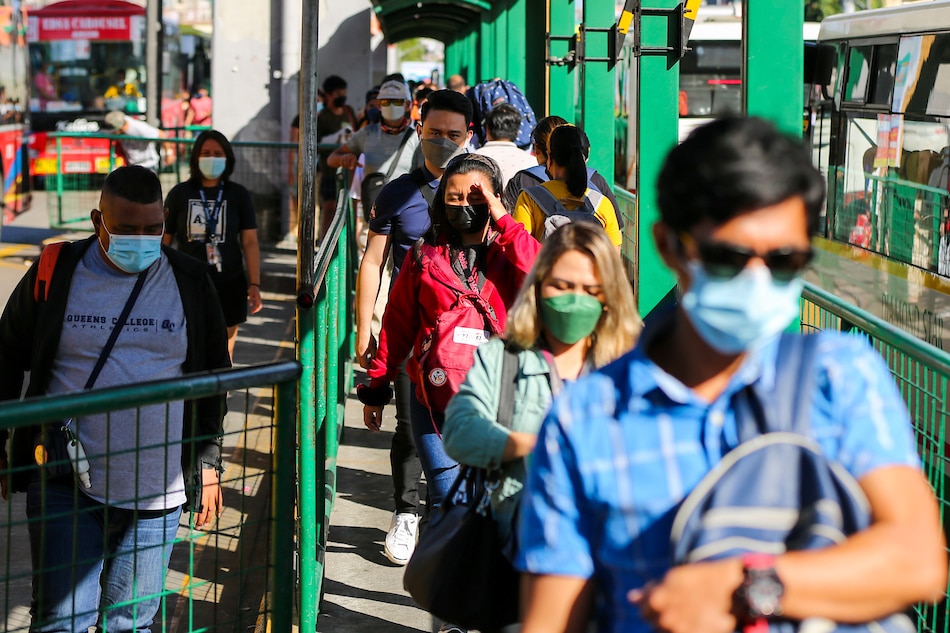Studies suggest omicron can act as 'natural vaccine' and push delta out with milder cases | ABS-CBN
ADVERTISEMENT

Welcome, Kapamilya! We use cookies to improve your browsing experience. Continuing to use this site means you agree to our use of cookies. Tell me more!
Studies suggest omicron can act as 'natural vaccine' and push delta out with milder cases
Studies suggest omicron can act as 'natural vaccine' and push delta out with milder cases
Wena Cos,
ABS-CBN News
Published Jan 05, 2022 06:58 PM PHT
|
Updated Jan 05, 2022 07:31 PM PHT
MANILA - Omicron may bring a massive spread of infection but also provide immunity to more members of a population, an expert said, opening up debates on whether the new variant is the last stage of the pandemic.
MANILA - Omicron may bring a massive spread of infection but also provide immunity to more members of a population, an expert said, opening up debates on whether the new variant is the last stage of the pandemic.
Despite its increased level of infection, omicron appears milder than the delta variant, and so post-surge it may leave us "in a better place than we were before," said Tyra Grove Krause, chief epidemiologist at Denmark's State Serum Institute.
Despite its increased level of infection, omicron appears milder than the delta variant, and so post-surge it may leave us "in a better place than we were before," said Tyra Grove Krause, chief epidemiologist at Denmark's State Serum Institute.
The UK Health Security Agency published a study updated on Dec 23 that found "the risk of presentation to emergency care or hospital admission with Omicron was approximately half of that for Delta."
The UK Health Security Agency published a study updated on Dec 23 that found "the risk of presentation to emergency care or hospital admission with Omicron was approximately half of that for Delta."
It also declared "a substantial reduction in risk of hospitalization for Omicron cases after 3 doses of vaccine compared to those who are unvaccinated."
It also declared "a substantial reduction in risk of hospitalization for Omicron cases after 3 doses of vaccine compared to those who are unvaccinated."
ADVERTISEMENT
This decrease in severity of the latest variant may be a good thing according to some experts, saying that a less severe variant could be something that people can live with more easily.
This decrease in severity of the latest variant may be a good thing according to some experts, saying that a less severe variant could be something that people can live with more easily.
OCTA Research Fellow Fr. Nicanor Austriaco Jr. said that omicron may become a "natural vaccine." Getting infected by the variant, which produces milder symptoms, will create immunity that will "vaccinate" those yet to be jabbed, and booster those already vaccinated.
OCTA Research Fellow Fr. Nicanor Austriaco Jr. said that omicron may become a "natural vaccine." Getting infected by the variant, which produces milder symptoms, will create immunity that will "vaccinate" those yet to be jabbed, and booster those already vaccinated.
"It protects against all variants," Austriaco Jr. said in a Townhall on Wednesday. "The omicorn infection actually gave [those studied] immunity not only against omicron, but against delta, gamma, beta, alpha, and the D614G, the variant from 2020 Jun-July surge in the Philippines."
"It protects against all variants," Austriaco Jr. said in a Townhall on Wednesday. "The omicorn infection actually gave [those studied] immunity not only against omicron, but against delta, gamma, beta, alpha, and the D614G, the variant from 2020 Jun-July surge in the Philippines."
Omicron numbers will definitely peak, and possibly exceed delta numbers, but Austriaco Jr. said the public should not fear this increase.
Omicron numbers will definitely peak, and possibly exceed delta numbers, but Austriaco Jr. said the public should not fear this increase.
"We should expect a significant population protection after the omicron wave passes," he said.
"We should expect a significant population protection after the omicron wave passes," he said.
ADVERTISEMENT
Edson Guido of ABS-CBN Data Analytics explains that this hope may come from the pattern observed in the delta surge in 2021.
Edson Guido of ABS-CBN Data Analytics explains that this hope may come from the pattern observed in the delta surge in 2021.
"Nagkaron tayo ng surge nung September, maraming na-infect, kaya after, nung following months, bumaba ang cases kasi nagkaroon ng natural immunity ang mga tao," he said.
"Nagkaron tayo ng surge nung September, maraming na-infect, kaya after, nung following months, bumaba ang cases kasi nagkaroon ng natural immunity ang mga tao," he said.
(We had a surge in September which was followed by a low number of cases, because people got natural immunity from infection.)
(We had a surge in September which was followed by a low number of cases, because people got natural immunity from infection.)
"The hope is that kung ang omicron ganun din ang mangyari," he added. "Eventually, kung maraming mai-infect ng omicron, nandoon ang possibility na mabilis tayong mag peak at bumaba rin ang numbers at tataas ang collective immunity natin against COVID."
"The hope is that kung ang omicron ganun din ang mangyari," he added. "Eventually, kung maraming mai-infect ng omicron, nandoon ang possibility na mabilis tayong mag peak at bumaba rin ang numbers at tataas ang collective immunity natin against COVID."
(The hope is to observe this again for omicron. When more people are infected with omicron, the numbers will peak and then decrease, and collective immunity will rise.)
(The hope is to observe this again for omicron. When more people are infected with omicron, the numbers will peak and then decrease, and collective immunity will rise.)
ADVERTISEMENT
However, local experts say this may not be true in the case of the Philippines, as vaccination rates are still low especially in areas outside of the capital.
However, local experts say this may not be true in the case of the Philippines, as vaccination rates are still low especially in areas outside of the capital.
"Kung yan ang premise natin, yung sinasabi sa Denmark, hindi natin ma-apply agad in the whole world or general population kasi may mga pasyente na mahina ang resistensya, unvaccianted, at wala pa siyang proteksyon. Mahirap makipagsapalaran," said health reform advocate Dr. Tony Leachon.
"Kung yan ang premise natin, yung sinasabi sa Denmark, hindi natin ma-apply agad in the whole world or general population kasi may mga pasyente na mahina ang resistensya, unvaccianted, at wala pa siyang proteksyon. Mahirap makipagsapalaran," said health reform advocate Dr. Tony Leachon.
(The premise in Denmark cannot be applied to the general population and the whole world, because a lot of people are unvaccinated and have weaker immune systems and protection. It will be difficult to gamble.)
(The premise in Denmark cannot be applied to the general population and the whole world, because a lot of people are unvaccinated and have weaker immune systems and protection. It will be difficult to gamble.)
Guido reminded that studies abroad are done in a different context than that of the Philippines.
Guido reminded that studies abroad are done in a different context than that of the Philippines.
"We also have to remember na itong mga studies na ito assumes and for these countries, mataas na ang vaccination sa kanila, so that helped. That's why we tell people to get vaccinated," he said.
"We also have to remember na itong mga studies na ito assumes and for these countries, mataas na ang vaccination sa kanila, so that helped. That's why we tell people to get vaccinated," he said.
ADVERTISEMENT
(We have to remember that the areas where these studies are done have high vaccination rates.)
(We have to remember that the areas where these studies are done have high vaccination rates.)
Despite being milder, a large number of omicron cases may still strain the healthcare system.
Despite being milder, a large number of omicron cases may still strain the healthcare system.
"Kung percentage ng severity ay mababa, at ang percentage ng number ay mataas, a small percentage multiplied by a very big number is still equal to a very big number," Guido added.
"Kung percentage ng severity ay mababa, at ang percentage ng number ay mataas, a small percentage multiplied by a very big number is still equal to a very big number," Guido added.
(A low percentage in severity multiplied by a great number of infections is still a very big number.)
(A low percentage in severity multiplied by a great number of infections is still a very big number.)
Healthcare facilities and hospitals being overwhelmed by the recent surge in numbers have already been reported.
Healthcare facilities and hospitals being overwhelmed by the recent surge in numbers have already been reported.
ADVERTISEMENT
Dr. Maricar Limpin of the Philippine College of Physicians said that more and more healthcare workers need to be isolated after contacting COVID-19.
Dr. Maricar Limpin of the Philippine College of Physicians said that more and more healthcare workers need to be isolated after contacting COVID-19.
"Dumadami ang kasamahan namin na hindi namin nakakasama sa trabaho, so nalessen ang workforce talaga," she said. "Not just yung mag doctors and nurses, pati yung radiology tech, yung medtechs, and even the drivers ng ambulance."
"Dumadami ang kasamahan namin na hindi namin nakakasama sa trabaho, so nalessen ang workforce talaga," she said. "Not just yung mag doctors and nurses, pati yung radiology tech, yung medtechs, and even the drivers ng ambulance."
(There are fewer people in the workforce after contacting COVID. Not just doctors and nurses, but other staff.)
(There are fewer people in the workforce after contacting COVID. Not just doctors and nurses, but other staff.)
The Alliance of Health Workers Philippines echoed this, saying that healthcare workers must be kept healthy so there would be people left to look after patients.
The Alliance of Health Workers Philippines echoed this, saying that healthcare workers must be kept healthy so there would be people left to look after patients.
"Kawawa ang healthcare workers at pasyente, kasi sino ang mangangalaga sa pasyente kung ang healthcare workers ay infected? (Who will take care of patients if the healthcare workers are also infected?)" he said.
"Kawawa ang healthcare workers at pasyente, kasi sino ang mangangalaga sa pasyente kung ang healthcare workers ay infected? (Who will take care of patients if the healthcare workers are also infected?)" he said.
ADVERTISEMENT
"Wala pang pandemya may understaffing na tayo. Ngayon lalong lumala pa kasi may mag nagresign, may nag early retirement, may nag-abroad, at itong mga ito hindi pa napapalitan ng panibagong healthcare workers," he added.
"Wala pang pandemya may understaffing na tayo. Ngayon lalong lumala pa kasi may mag nagresign, may nag early retirement, may nag-abroad, at itong mga ito hindi pa napapalitan ng panibagong healthcare workers," he added.
(We have been understaffed even before the pandemic. Now there are even fewer of us, because some have resigned, retired, and left the country. Those who have gone have not yet been replaced.)
(We have been understaffed even before the pandemic. Now there are even fewer of us, because some have resigned, retired, and left the country. Those who have gone have not yet been replaced.)
Leachon added that a surge in cases will also be felt economically.
Leachon added that a surge in cases will also be felt economically.
"Kahit mild yan, pag nagkaroon ka, i-isolate and quarantine ka, so hindi pa rin makakapasok ang mga empleyado. Ang effect niya hindi sa mortality or death, but the sheer volume can jeopardize and cause economic depression," he explained.
"Kahit mild yan, pag nagkaroon ka, i-isolate and quarantine ka, so hindi pa rin makakapasok ang mga empleyado. Ang effect niya hindi sa mortality or death, but the sheer volume can jeopardize and cause economic depression," he explained.
(Even if it's mild, people who get it will still have t isolate. They won't be able to work. The effect may not be mortality or death, but the sheer volume can jeopardize and cause economic depression.)
(Even if it's mild, people who get it will still have t isolate. They won't be able to work. The effect may not be mortality or death, but the sheer volume can jeopardize and cause economic depression.)
ADVERTISEMENT
On Tuesday the World health Organization in Europe said that soaring omicron cases around the globe could increase the risk of a newer, more dangerous variant emerging.
On Tuesday the World health Organization in Europe said that soaring omicron cases around the globe could increase the risk of a newer, more dangerous variant emerging.
"The more omicron spreads, the more it transmits and the more it replicates, the more likely it is to throw out a new variant. Now, omicron is lethal, it can cause death ... maybe a little bit less than delta, but who's to say what the next variant might throw out," said WHO Senior Emergencies Officer Catherine Smallwood to AFP.
"The more omicron spreads, the more it transmits and the more it replicates, the more likely it is to throw out a new variant. Now, omicron is lethal, it can cause death ... maybe a little bit less than delta, but who's to say what the next variant might throw out," said WHO Senior Emergencies Officer Catherine Smallwood to AFP.
The Department of Health echoed this, saying that being an "agent of transmission" makes one an "agent of mutation."
The Department of Health echoed this, saying that being an "agent of transmission" makes one an "agent of mutation."
With the slowing of vaccination over the holidays, Guido said that the Philippines may be able to vaccinate 70% of its population by April. But he reminded that breakthrough COVID cases, or infections even after vaccination, may change the game.
With the slowing of vaccination over the holidays, Guido said that the Philippines may be able to vaccinate 70% of its population by April. But he reminded that breakthrough COVID cases, or infections even after vaccination, may change the game.
"Kung mapapabilis, pwedeng within the first quarter, before March, 70 percent is no longer enough against delta, I'm pretty sure it won't be enough against omicron lalo. Booster shots na ang magiging bilangan natin moving forward," he said.
"Kung mapapabilis, pwedeng within the first quarter, before March, 70 percent is no longer enough against delta, I'm pretty sure it won't be enough against omicron lalo. Booster shots na ang magiging bilangan natin moving forward," he said.
ADVERTISEMENT
(If vaccination is fast-tracked, we might be able to vaccinate 70 percent of the population by March. But 70 percent is no longer enough, not with delta, nor omicron. Booster shots will make the difference moving forward.)
(If vaccination is fast-tracked, we might be able to vaccinate 70 percent of the population by March. But 70 percent is no longer enough, not with delta, nor omicron. Booster shots will make the difference moving forward.)
Surveillance needs to be ramped up, Leachon added, to be able to tell for certain if the recent spike in cases are indeed omicron.
Surveillance needs to be ramped up, Leachon added, to be able to tell for certain if the recent spike in cases are indeed omicron.
"We cannot manage what we don't measure, how can we manage without testing?" he said.
"We cannot manage what we don't measure, how can we manage without testing?" he said.
"Unahin natin ang testing na libre, tapos tracing, at bakuna and booster. Focus tayo sa strategy, hindi natin pwede i-blame ang mga tao, ang tagal na nating ganito," he added.
"Unahin natin ang testing na libre, tapos tracing, at bakuna and booster. Focus tayo sa strategy, hindi natin pwede i-blame ang mga tao, ang tagal na nating ganito," he added.
(We should strategize and prioritize free testing, and then tracing, and vaccination and booster. We can't keep blaming the people we have been at this for so long.)
(We should strategize and prioritize free testing, and then tracing, and vaccination and booster. We can't keep blaming the people we have been at this for so long.)
ADVERTISEMENT
The DOH earlier said it assumes the the omicron variant has spread to the communities as cases nationwide tripled in just several days.
The DOH earlier said it assumes the the omicron variant has spread to the communities as cases nationwide tripled in just several days.
The country's total recorded COVID-19 cases stood at 2,861,119, as of Tuesday, of which, 29,809 are active. Of those still battling the disease, 328 are in critical condition, 1,546 are severely ill, and 3,020 are moderate.
The country's total recorded COVID-19 cases stood at 2,861,119, as of Tuesday, of which, 29,809 are active. Of those still battling the disease, 328 are in critical condition, 1,546 are severely ill, and 3,020 are moderate.
Intensive care unit beds for COVID-19 cases are 35 percent used up in Metro Manila, and 26 percent across the country. Ventilators are 20 percent utilized in the capital region, and 14 percent nationwide.
Intensive care unit beds for COVID-19 cases are 35 percent used up in Metro Manila, and 26 percent across the country. Ventilators are 20 percent utilized in the capital region, and 14 percent nationwide.
ADVERTISEMENT
ADVERTISEMENT






